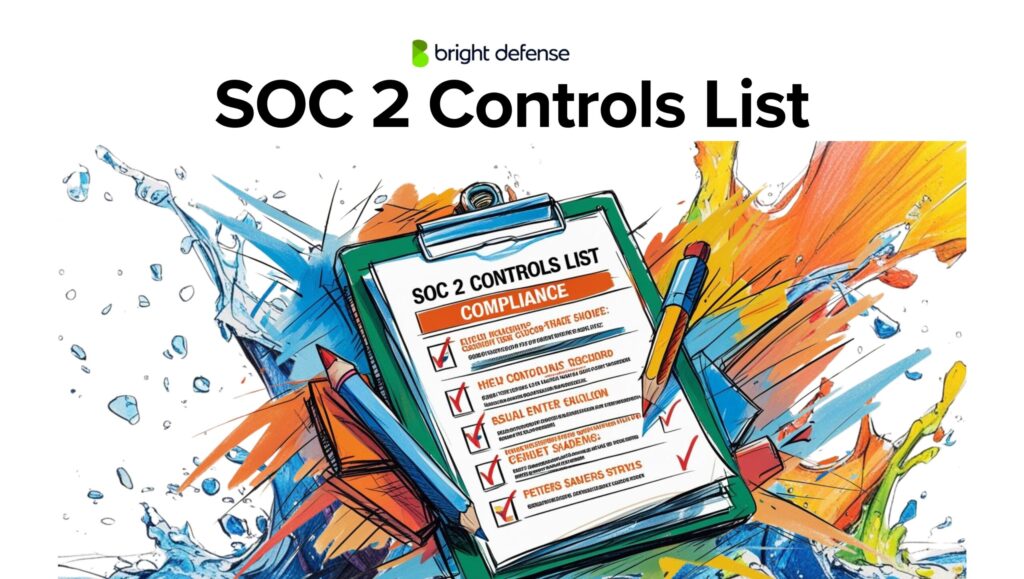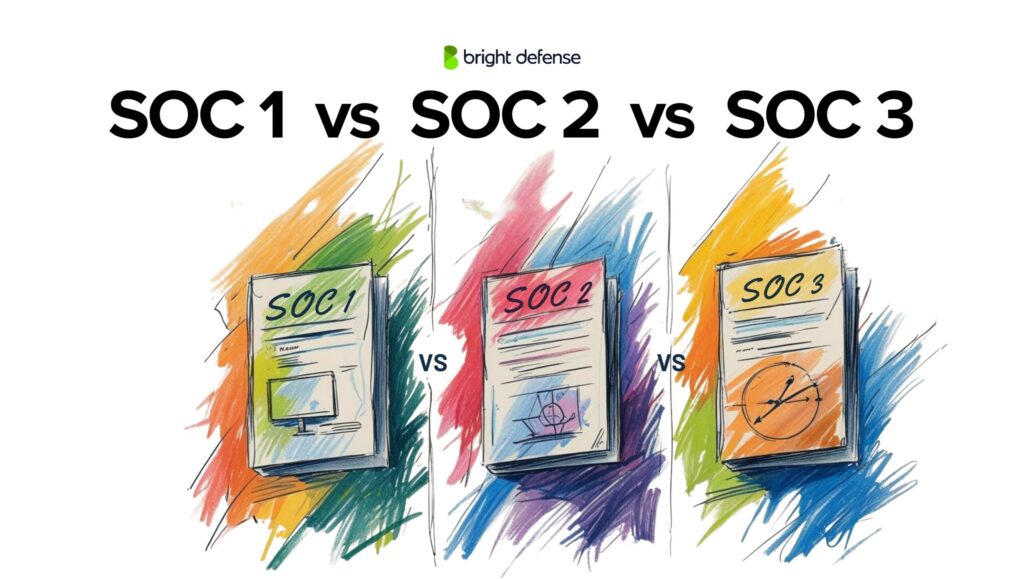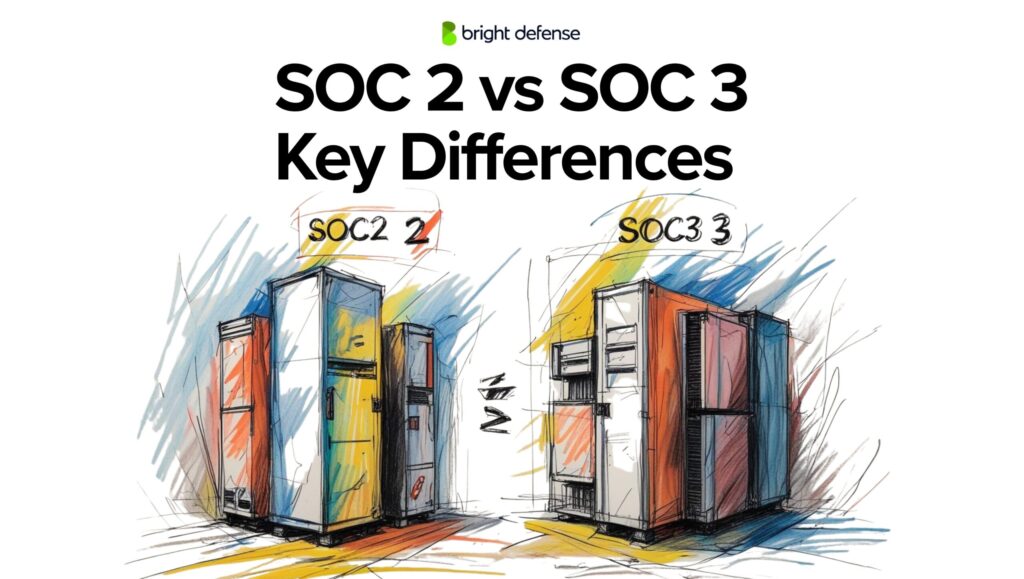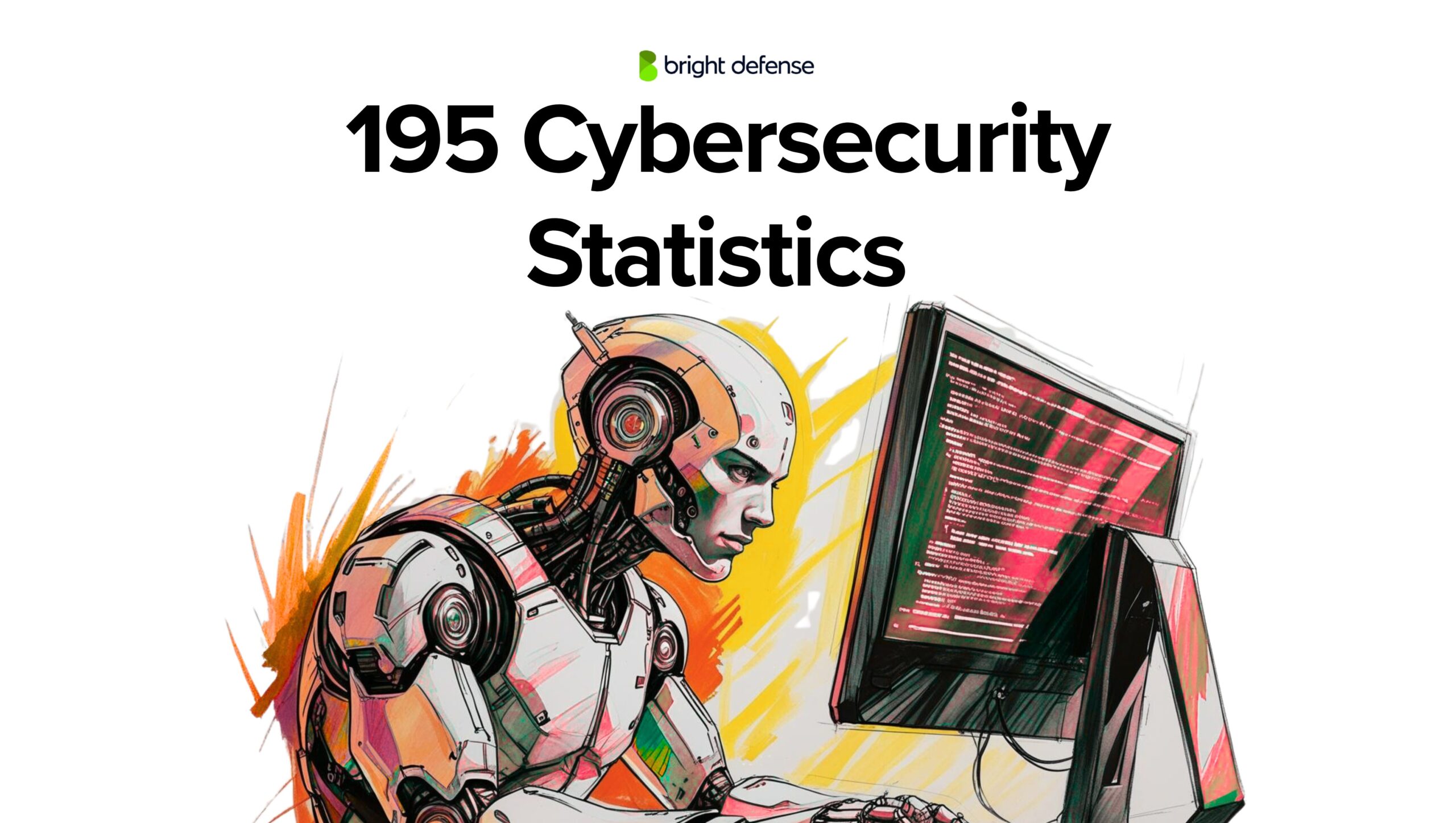
John Minnix - Compliance Strategist
June 29, 2025
195 Cybersecurity Statistics (Updated June-2025)
The team at Bright Defense has compiled a comprehensive list of up-to-date cybersecurity statistics for 2024. In this article, you’ll find hand-picked statistics about:
- Global cybersecurity statistics
- Cybercrime statistics
- Cybersecurity employment statistics
- AI cybersecurity stats
Without further ado, let’s see the stats!
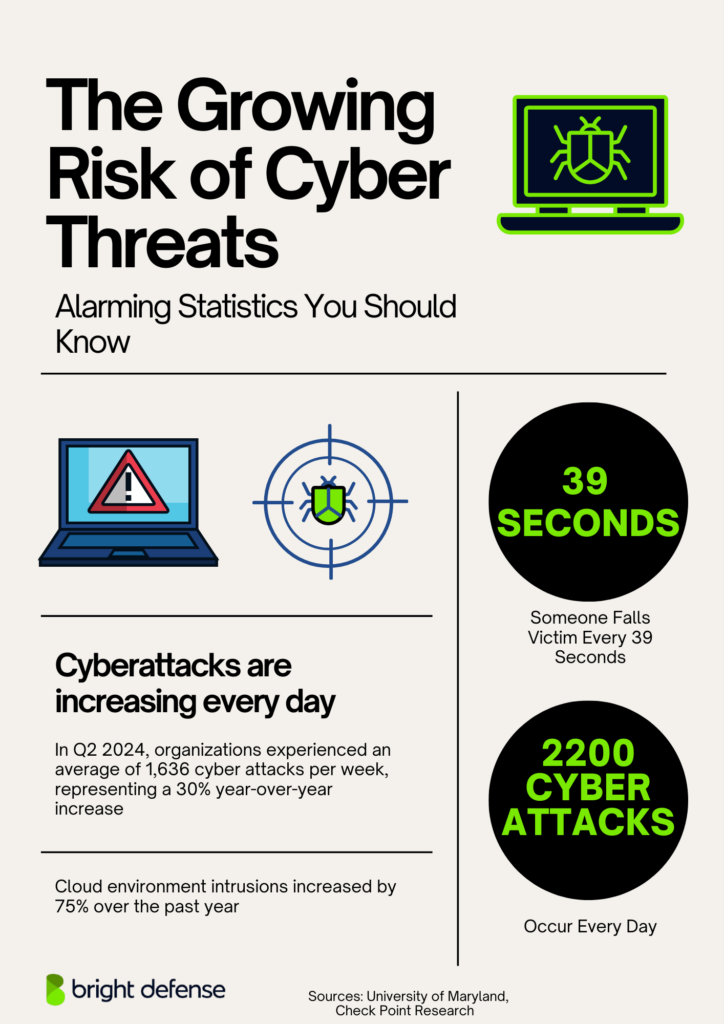
Global Cybersecurity Statistics
- Only 3% of organizations globally have the “Mature” level of readiness to be resilient against cybersecurity risks. (Cisco)
- Over 2,200 cyberattacks occur daily worldwide. (Demandsage.com)
- Cybercrime losses reported to the FBI’s Internet Crime Complaint Center (IC3) increased by 22% between 2022 and 2023. (Cobalt.io)
- The cybersecurity technology market was valued at $185.7 billion in 2024. (techopedia.com)
- On average, 12% of IT budgets are spent on cybersecurity. (Business)
- 97% of businesses expect to increase their cybersecurity budgets in the 12 months. (Cisco)
- Worldwide spending on security and risk management is projected to reach $215 billion in 2024, a 14.3% increase from 2023. (Gartner)
- 83% of large businesses see security as a significant threat the their business. (IBM)
- 78% of small and medium businesses say they will increase investment in cybersecurity in the next 12 months. (AAG IT)
- The security services segment, comprised of consulting, IT outsourcing, implementation, and hardware support, is the largest security segment with projected revenues of almost $90 billion in 2024. (Gartner)
- 51% of organizations plan to increase security investments due to a breach. (IBM)
- 51% of business leaders view cybersecurity as a key business enabler. This compares to 37% who view it as a necessary cost of doing business. (PracticalEcommerce)
- 80% of organizations use cybersecurity automation tools. (Security Boulevard)
- Cloud security spending is expected to increase at 24.7% rate between 2023 and 2024, the fastest of any segment. (Gartner)
- 62% of IT leaders do not believe they effectively securing their cloud resources. (Arctic Wolf)
- 42% of IT leaders said that cloud security gaps were their primary area of concern. (Arctic Wolf)
- 49% of business leaders rated modernization of technology including cyber infrastructure as their top priority over the next 12 months. (PWC)
- Legal and compliance department investment in tools for governance, risk, and compliance will increase by 50% by 2026. (Gartner)
- 40% of organizations are planning to introduce a security awareness training program within the coming year. (Arctic Wolf)
- The average US employee has 75 passwords. (Spacelift)
- Only 27% of business leaders were confident that their organization was cyber-resilient in 2023. (PracticalEcommerce)
- 83% of small US business are not financially prepared to recover from a cybersecurity attack. (Mastercard)
- Basic cybersecurity hygiene can protect against 98% of attacks. (Microsoft)
- 24% of organizations say that building a culture of security awareness is an urgent concern. (Arctic Wolf)
- About 52% of businesses and 38% of charities had a policy against paying ransomware demands. These figures are similar to those reported in 2024, when 48% of businesses and 37% of charities held the same stance. (GOV.Uk)
- Multi-factor authentication prevents 99.9% of phishing attacks. (Microsoft)
- 46% businseses in the Denmark uses multifactor authentication, making it the global leader in mfa usage. (LastPass)
- Zero trust adoption increased to 33% in 2023. (Security Boulevard)
- About 90% of businesses in the United States have a cyber insurance policy. (Lastpass)
- Only 17% of small businesses encrypt data. (Small Business Trends)
- 53% of small businesses have over 1,000 unencrypted sensitive folders. (Small Business Trends)
- Just 4% of organizations feel confident that their security protects users of connected devices and related technologies against cyberattacks. (National University)
- 97% of businesses expect to increase their cybersecurity budgets in the next 12 months. (Source: Cisco)
- Worldwide spending on security and risk management is projected to reach $215 billion in 2024, a 14.3% increase from 2023. (Source: Gartner)
- Cybersecurity budgets grew by 8% in 2024, a modest increase from 6% in 2023, but still below the growth rates of 16% in 2021 and 17% in 2022. (IANS)
- Security budgets now represent 13.2% of total IT spending, up from 8.6% in 2020. (Help Net Security)
- Cloud security breaches surged by 35% compared to 2023, with 78% of organizations reporting at least one incident. The average cost of a breach reached $5.1 million. (Cloud Essentials)
- Deloitte estimates that 25% of companies using generative AI will launch agentic AI pilots in 2025, with that number rising to 50% by 2027. (Axios)
- Organizations that identified breaches using their own security teams and tools had breach costs nearly $1 million lower on average than those identified by attackers. (IBM – United States)
- Nearly two-thirds of organizations plan to increase security investments following a breach, focusing on areas like identity access management and data protection tools. (IBM – United States)
- Only 17% of small companies have cyber insurance, highlighting a significant gap in preparedness. (Risk Solutions)
- 52% of small and medium-sized businesses (SMBs) want support with training and education, while 51% cite keeping up with new threats as their main challenge. (Risk Solutions)
- Low awareness, inadequate implementation strategies, and lack of incentives are primary obstacles hindering SMBs from adopting effective cyber readiness measures. (Cyber Readiness Institute)
- Security vendors like 1Password, Okta, and OwnID have launched tools to manage AI agent identities, addressing the urgent need for identity and security measures for AI agents performing autonomous tasks. (Axios)
- The telecommunications industry was a prime target in 2024, with Chinese hacking campaigns targeting telecom networks for espionage. (NordLayer)
- In the financial sector, banks are increasingly vulnerable to service disruptions due to their growing reliance on complex, legacy technology systems. (NordLayer)
- The cybersecurity market is expected to reach $266 billion by 2027. (Exploding Topics)
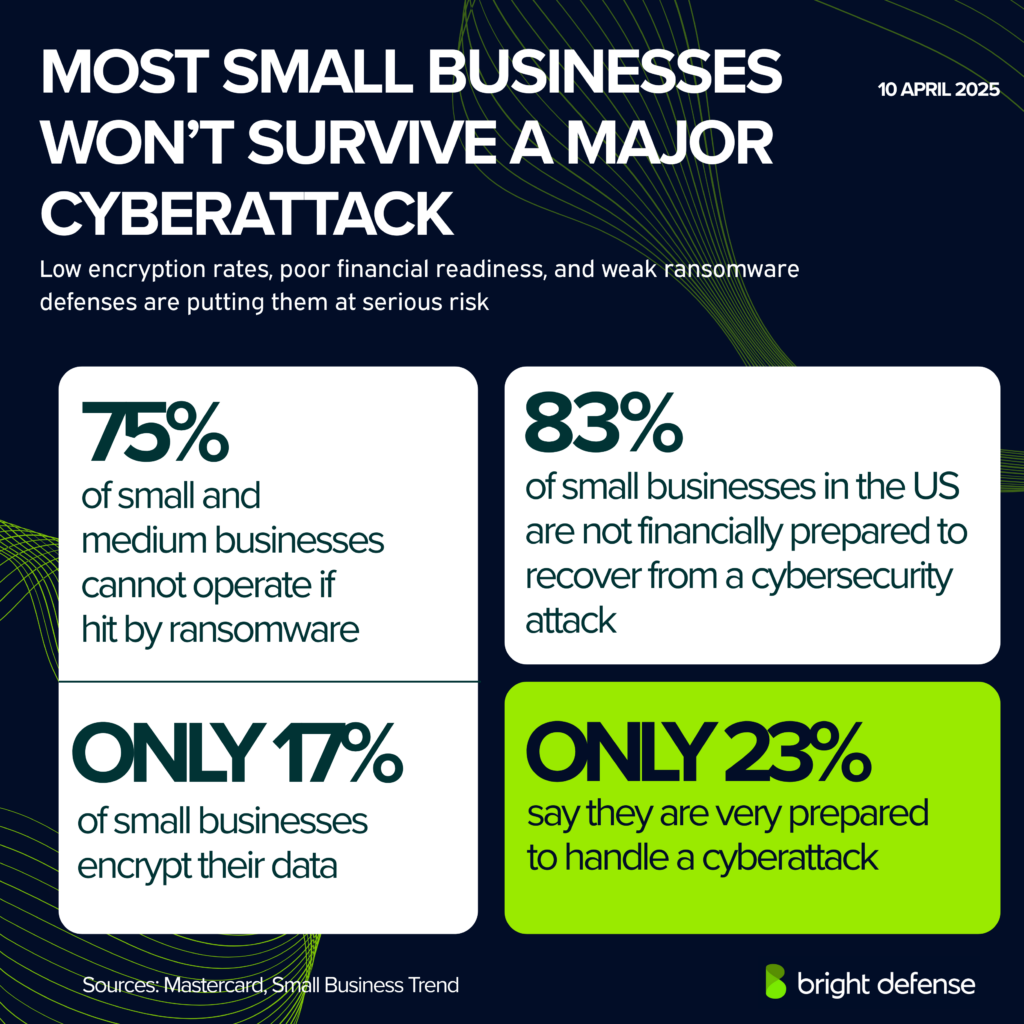
Cybercrime Statistics
- Global cybersecurity crime damage is expected to hit $10.5 trillion by 2025. (Cybercrime Magazine)
- If cybercrime were a country, it would be the world’s third-largest economy after the United States and China. (KnowB4)
- Global cybercrime damage costs are anticipated to grow by 15% annually over the next two years. (Cobalt: Top Security Stats)
- There were 425,078,513 victims of cybercrime in 2022. (Identity Theft Resource Center)
- 92% of U.S. healthcare organizations experienced a cyberattack in the past year. (HIPAA Journal)
- 73% of companies expect a cybersecurity incident to disrupt their business in the next 12 to 24 months. (Cisco)
- Nearly half (47%) of companies have a policy to pay ransoms associated with cybersecurity threats.
- Hackers attack a computer with internet access every 39 seconds on average, or 2,244 times per day. (Clark School)
- The FBI’s Internet Crime Report showed that business email compromises cost US businesses $5,136.98 per minute in 2022. (The SSL Store)
- Ransomware recovery costs averaged $3.58 million in 2024. (cobalt.io)
- 52% of organizations affected by a cybersecurity incident in the last 12 months said it cost them at least $300,000. (Cisco)
- Phishing attacks were responsible for more than 40% of social engineering incidents in 2024. (Techopedia.com)
- Approximately 46% of all emails sent worldwide were spam in 2024. (Techopedia.com)
- In 2024, 86% of malware was delivered through emails. (demandsage)
- 63% of ransomware attackers demanded $1 million or more, and 30% demanded over $5 million in 2024. (Cobalt.io)
- Seven million unencrypted files are compromised daily. (Small Business Trends)
- Reports of financial penalties from phishing incidents rose by 144% year-on-year in 2024. (Techopedia.com)
- An estimated 33 billion electronic records were stolen in 2023. (Juniper Research)
- The average cost of a data breach reached $4.45 million in 2023, an increase of 15% over the previous three years. (IBM)
- Cryptojacking decreased globally by 60% in 2024, except in India where it increased by 409%. (Sentinelone.com)
- 15% of all malware leveraged software packing as the primary MITRE TTP in 2024. (Sentinelone.com)
- 43% of cybersecurity attacks targeted small and medium businesses. (Small Business Trends)
- Telephone-oriented attack attempts increased to an average of 300,000 to 400,000 thousand calls made daily. (Proofpoint)
- Cyberattacks increased by 30% globally in 2024 compared to the previous year. (Demandsage.com)
- The education and research industry faced the highest threat, with 3,341 attacks per week in 2024. (Demandsage.com)
- Africa experienced the most weekly attacks per organization, averaging 2,960 in 2024. (Demandsage.com)
- The manufacturing sector led in ransomware attacks, accounting for 29% of incidents in 2024. (Demandsage.com)
- Cyber insurance costs increased by 28% in 2024. (Demandsage.com)
- 87% of small enterprises hold customer data that could be compromised during an attack. (Small Business Trends
- In 2023, Data breach costs were up 21.4% for companies with 500 to 1,000 employees, and 13.4% for companies with fewer than 500 employees. Data breach costs had decreased for companies with over 5,000 employees. (The SSL Store)
- Ransomware damages are expected to reach $265 billion by 2031. (Cybercrime Magazine)
- 69% of ransomware attacks are delivered by email. (Barracuda)
- 48% of organizations see ransomware as the attack vector they are most concerned by. This is followed by Phishing (33%), and email compromise (33%). (Arctic Wolf)
- Ransomware attacks were the most costly data breach in 2023, with an average cost of $4.62 million. (IBM)
- California had the highest losses from cybercrime of any US state in 2022, at over $2 billion. This is followed by Florida, New York, Texas, and Georgia. (Statista)
- In the first half of 2023, there were 1,862 publicly disclosed data breaches, exposing over 22 billion records. (Identity Theft Resource Center)
- Data was encrypted in 76% of attacks. In 97% of those instances, organizations got their data back. (Sophos)
- 75% of small and medium businesses cannot operate if hit by ransomware. (Small Business Trends)
- There was a 1620% increase in Zero-Day attaches in the first three quarters of 2023, compared to all of 2022. (Identity Theft Resource Center)
- Companies take an average of 277 days to identify and respond to a cyberattack. (Cyforsecure)
- 80% of external software exploits were previously known vulnerabilities that were not mitigated. (The SSL Store)
- 83% of breaches involved external parties. (Verizon)
- 85% of breaches involved human error. (Security Boulevard)
- Stolen credentials are a factor in 49% of data breaches. (The SSL Store)
- Cyberattacks targeting the software supply chain will cost the global economy $80.6 billion annually by 2026. (Juniper Research)
- Only 23% of affected companies implemented cybersecurity training after attacks. (New York Post)
- Phishing attacks were the most common type of data breach in 2023, accounting for 36% of all breaches. (Verizon)
- 66% of organizations were hit with ransomware in 2023. (Sophos)
- 47% of ransomware targeted the United States in April 2023. (Malwarebytes)
- There are over 560,000 new malware threats daily. (Security Boulevard)
- Over 1,000 ransomware variants are currently active. (Malwarebytes)
- Ransomware attacks occurred every 11 seconds in 2023, with an average ransom demand of $170,404. (Sophos)
- Ransomware as a Service (RaaS) operations are becoming increasingly sophisticated, with over 100 active RaaS groups operating worldwide. (Chainalysis)
- Ransomware as a service attacks can be purchased for as little as $40. (Crowdstrike)
- The total value received by ransomware attackers dropped from $766 million in 2021 to $457 million in 2022, due to more victims refusing to pay their attacker. (Chainalysis)
- 36% of respondents to a 2024 survey from PWC said they had a data breach that caused $1 million or more in damages over the previous three years. (PWC)
- The healthcare industry had the highest average cost per data breach at $5.3 million. (PWC)
- The average healthcare record costs $675 on the black market. (The SSL Store)
- 2,025 US schools, colleges, and universities were victims of ransomware attacks in 2022. (The SSL Store)
- Nearly half (47%) of companies have a policy to pay ransoms associated with cybersecurity threats. (CFO)
- The average cost of a ransomware attack in 2023 was $4.54 million. (SOCRadar® Cyber Intelligence Inc.)
- Bitcoin remains the most popular cryptocurrency for ransomware payments, accounting for over 98% of all transactions. (Elliptic)
- Nation-state threats to critical infrastructure increased by 40% in 2022. (The SSL Store)
- 27% of law firms reported that they have had at least one data breach. (Legal Talk Network)
- Cybercrime rates increased 125% during the covid pandemic. (Global Security Mag)
- The largest DDoS attack was 1.3 terabytes per second. (Fortra)
- Nearly half (45%) of employed people have fallen victim to cyberattacks or scams. (New York Post)
- Reports of reputational damage from phishing incidents increased by 50% in 2024. (Techopedia.com)
- In 2024, phishing attacks were the most common type of data breach, accounting for 36% of all breaches. (Techopedia.com)
- Email phishing attacks increased by 25% in 2024 compared to the previous year.(Techopedia.com)
- Spear phishing attacks accounted for 65% of targeted phishing campaigns in 2024. (Techopedia.com)
- Clone phishing incidents rose by 30% in 2024. (Techopedia.com)
- Business email compromise (BEC) attacks resulted in losses exceeding $2.4 billion in 2024. (Techopedia.com)
- The average cost per BEC incident was $120,000 in 2024. (Techopedia.com)
- A total of 22,254 Common Vulnerabilities and Exposures (CVEs) were reported by mid-2024, a 30% increase compared to 2023. (Indusface.com)
- By late 2024, an average of 115 CVEs were disclosed daily. (Indusface.com)
- Vulnerability-based attacks surged by 124% in Q3 2024 compared to the same period in 2023. (Indusface.com)
- In 2024, 0.91% of all CVEs were weaponized, representing a 10% year-over-year increase. (Indusface.com)
- Vulnerabilities like CVE-2024-5806 in Progress MOVEit Transfer were exploited within hours of disclosure in 2024. (Indusface.com)
- Between November 2021 and October 2023, over 70% of cyberattacks globally targeted the Microsoft Office Suite.(Indusface.com)
- Browser exploits accounted for nearly 12% of attacks during the same period.(Indusface.com)
- In 2023, 38% of intrusions began with attackers exploiting vulnerabilities, a 6% increase compared to the previous year. (Indusface.com)
- As of October 2024, AppTrana detected 2,028 zero-day vulnerabilities, averaging 225 discoveries per month. (Indusface.com)
- Over 50% of the most exploited vulnerabilities in 2023 were zero-days. (Indusface.com)
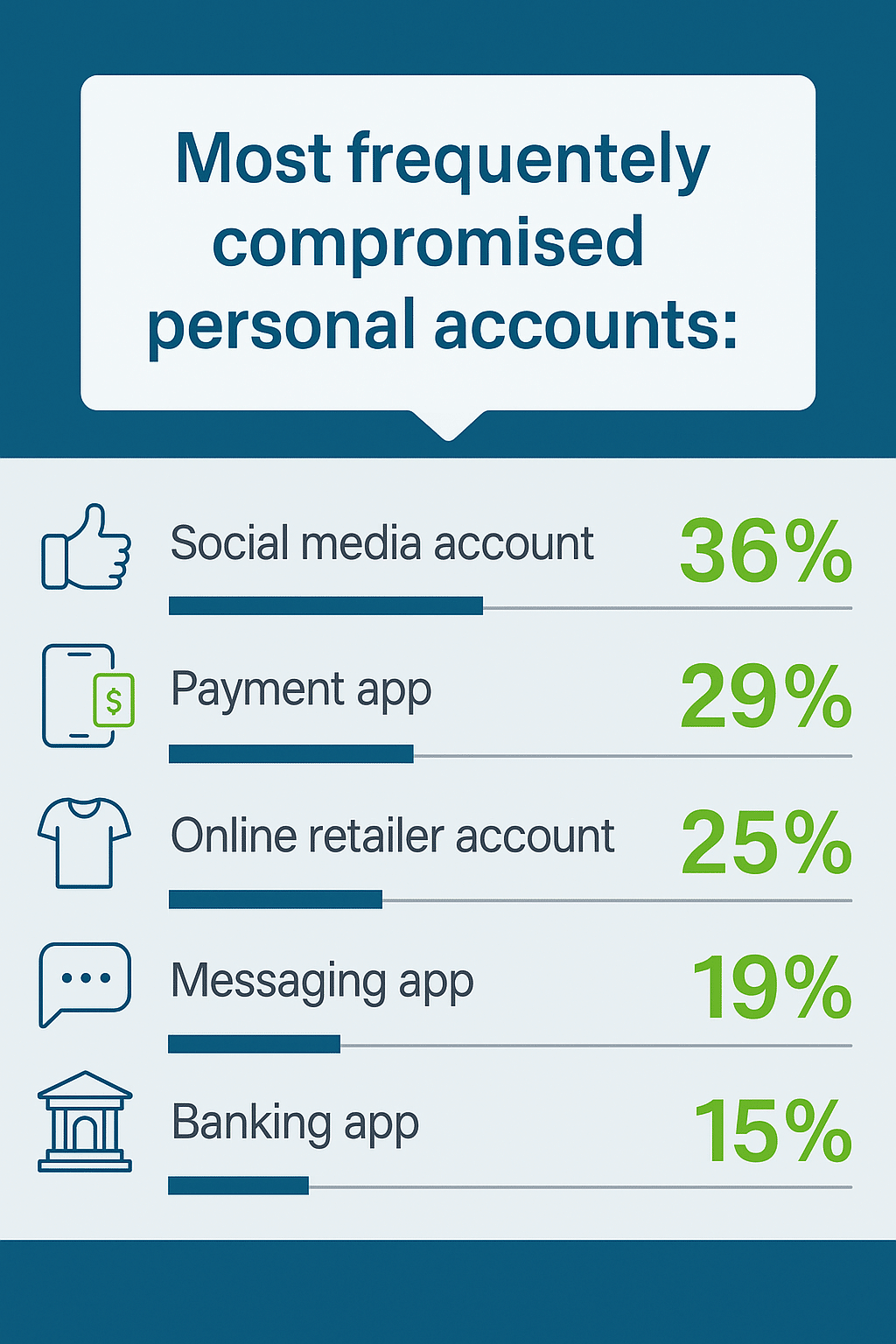
Want more cybercrime data? Read our massive guide with 200+ up-to-date cybercrime statistics.
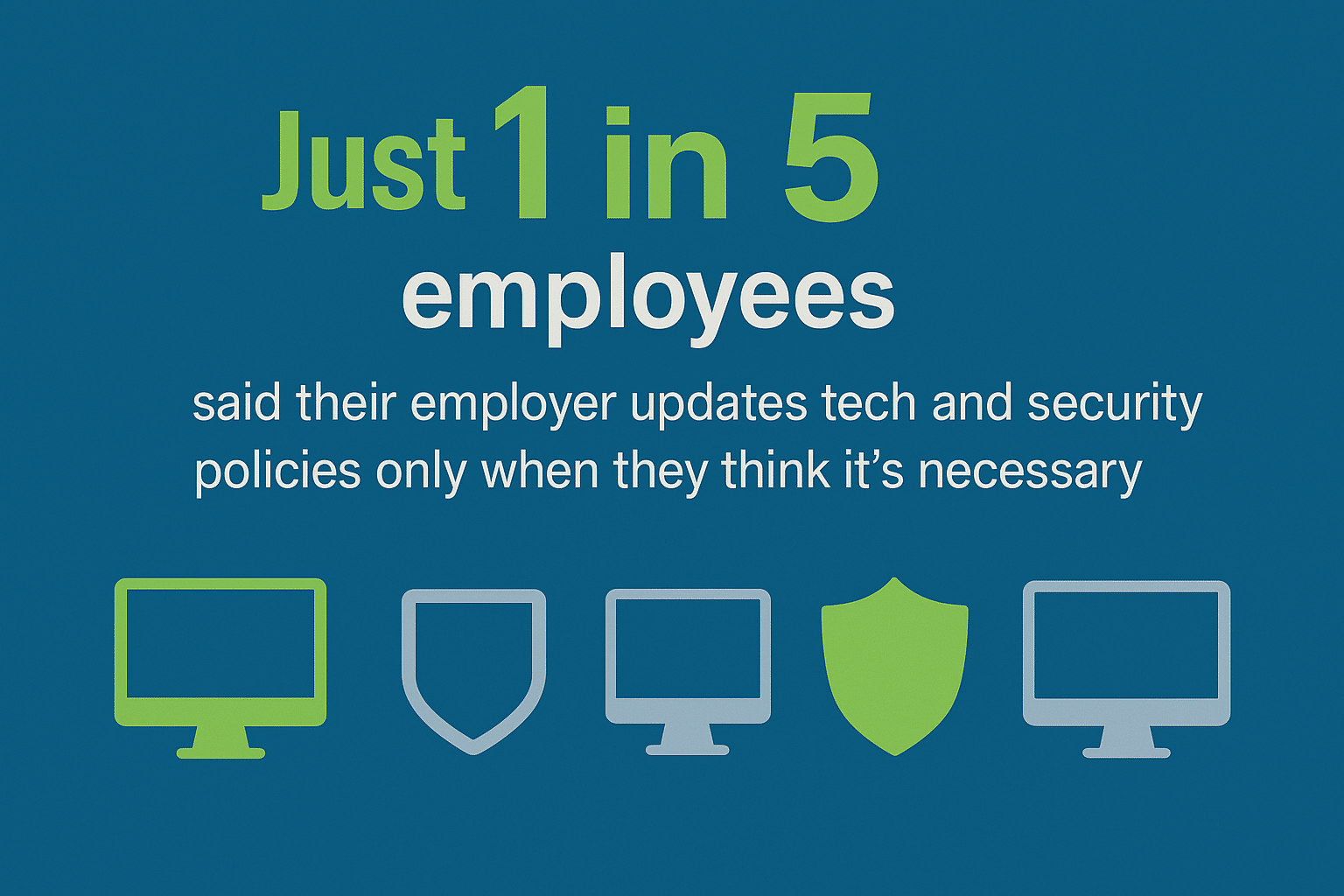
Cybersecurity Employment Statistics
- By 2026, 70% of boards will include at least one member with expertise in cybersecurity. (Gartner)
- The world had 3.5 million unfilled cybersecurity jobs in 2023. (Cybercrime Magazine)
- Cybersecurity job growth is anticipated to be 35% over the next decade. (Monster.com)
- Women make up only 24% of the cybersecurity workforce. (Cybernews)
- 68% of organizations say that staffing issues are the top threat to achieving their cybersecurity objectives. (Arctic Wolf)
- 46% of companies in a Cisco survey said they had more than 10 unfilled cybersecurity roles at the time of survey in 2024. (Cisco)
- Cybersecurity Security Specialists, an entry-level role in cybersecurity, earn an overage of $102,677. (Monster)
- 67% of small and medium businesses say they do not have the in-house expertise to deal with a data breach. (AAG IT)
- 47% of cyber leaders say they have some training gaps or critical people or skills gaps. (PracticalEcommerce)
- 71% of organizations say they have been impacted by the cybersecurity skills shortfall. (Help Net Security)
- 61% of mid-sized businesses have no dedicated cybersecurity staff. (Help Net Security)
- Only 9% of organizations say their workers adhere to security best-practices. (Help Net Security)
- The global cybersecurity workforce was estimated at 4.7 million professionals in 2025. (NU.EDU)
- The U.S. had only enough cybersecurity workers to fill 74 out of every 100 open jobs in 2025. (Axios.com)
- Cybersecurity job listings in the U.S. grew by 12% between May 2024 and April 2025. (Axios.com)
- Employers listed more than 514,000 cyber-related jobs during that period. (Axios.com)
- Only 54% of cybersecurity roles required a bachelor’s or graduate degree, indicating a shift towards nontraditional hiring. (Axios.com)
- In 2025, 10% of employers recruiting for cyber jobs explicitly listed AI as a required skill. (Axios.com)
- Virginia, California, and Texas had the most cybersecurity job postings in 2025. (Axios.com)
- The cybersecurity skills gap could reach 85 million by 2030 if not addressed. (Sentinelone.com)
- A lack of resources and skills was the biggest challenge for 52% of organizations in designing cyber resilience in 2024. (Admin Magazine)
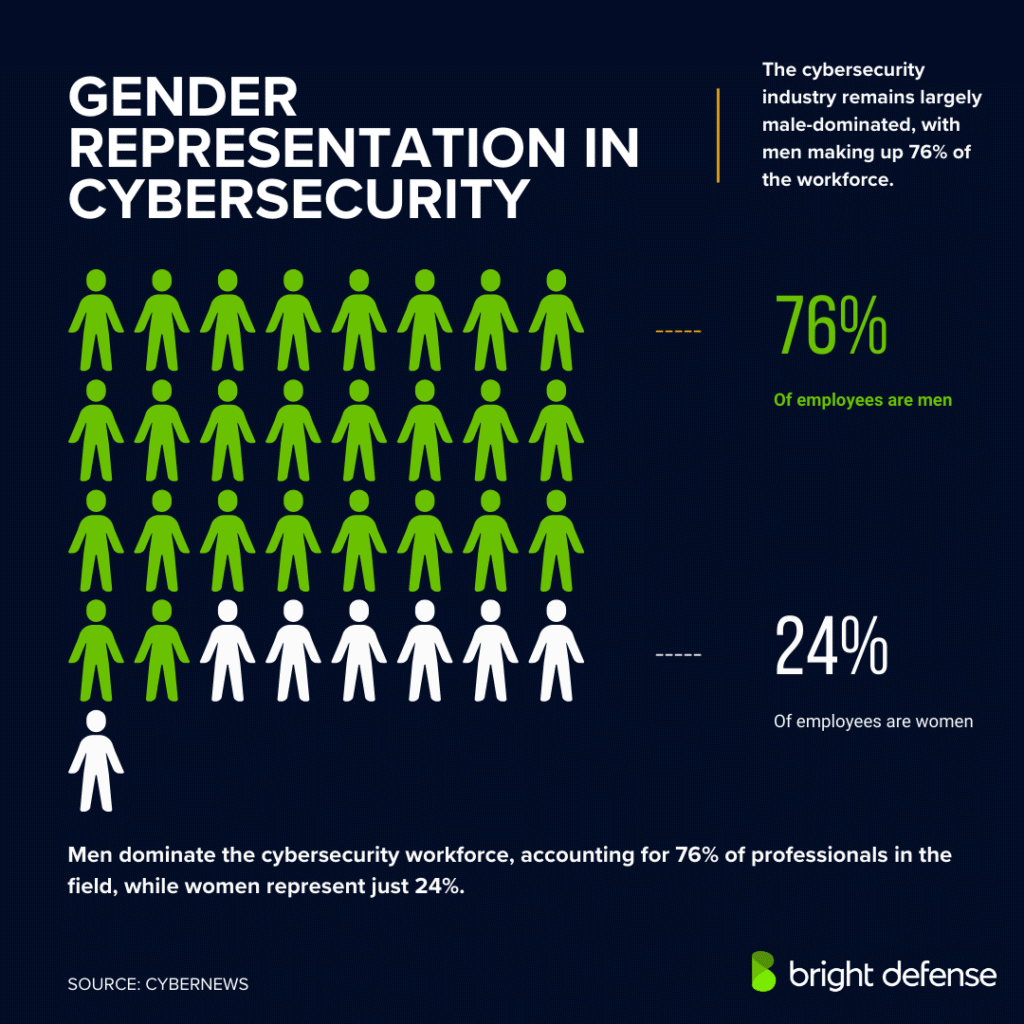
General Trust in Online Information
- 41% of online content is believed to be accurate, fact-based, and human-created. (Talker Research)
- 23% is considered completely false and purposely misleading. (Talker Research)
- 36% falls somewhere in between. (Talker Research)
- 75% say they trust the internet less today than ever before. (Talker Research)
- 78% believe the internet has “never been worse” for telling real from artificial. (Talker Research)
AI Cybersecurity Statistics
- The AI in cybersecurity market was valued at $22.4 billion ion 2023, and will expand to $60.6 billion by 2028. This represents a growth rate of 21.9%. (Markets and Markets)
- Organizations that use security AI save $1.76 million on average compared to organizations that don’t. (IBM)
- The average American encounters suspected AI-generated information 5 times per week. (Talker Research)
- 21% of organizations are seeing benefits to their security programs due to Gen AI. (PWC)
- North America account for 35.1% of AI cybersecurity revenue, representing the largest region. (Grand View Research)
- 82% of people believe businesses should be legally required to disclose when they use AI in marketing, content, customer service, and websites. (Talker Research)
- The enterprise business segment has the leading revenue share for cyber-AI at 23.7%. Banking, financial services, and insurance (BFSI) was the second largest vertical. (Grand View Research)
- 47% of organizations are using AI for cyber risk detection and mitigation. (PWC)
- 69% of organizations say they cannot respond to cyber threats without AI. (Enterprise Apps Today)
- 40% of organizations with more than 500 employees use AI-driven cybersecurity tools. (Enterprise Apps Today)
- According to the study, 43% of respondents say that talking to a customer service representative is the most stressful situation when trying to distinguish between AI and a human. Another 23% report feeling stressed when booking lodging or hotels, while 22% express concern when sending money through a third-party app. (Talker Research)
- 55% of organizations plan to invest in AI-driven security technologies over the next 12 to 24 months. (Cisco)
- Ransomeware victims saved an average of $470,000 and 33 days when they involved law enforcement after a data breach. (IBM)
- 78% of respondents believe that Gen AI will lead to a catastrophic cyber attack. (PWC)
- 69% of organizations say they will use Gen AI for cyber defense in the next 12 months. (PWC)
- 83% of companies surveyed say that auditors should incorporate AI in their audit process. (CFO Brew)
- 15% say they see AI-generated content more than 10 times per week. 82% of respondents believe businesses should be legally required to disclose when they use AI in marketing, content, customer service, and websites.
- Americans estimate that 50% of the news and articles online contain some form of AI-generated content. (Talker Research)
- In the TalkerResearch study, 48% of respondents cited social media posts as the leading source of AI-generated or misleading content, followed by 34% who pointed to news articles and 32% who identified chatbots. (Talker Research)
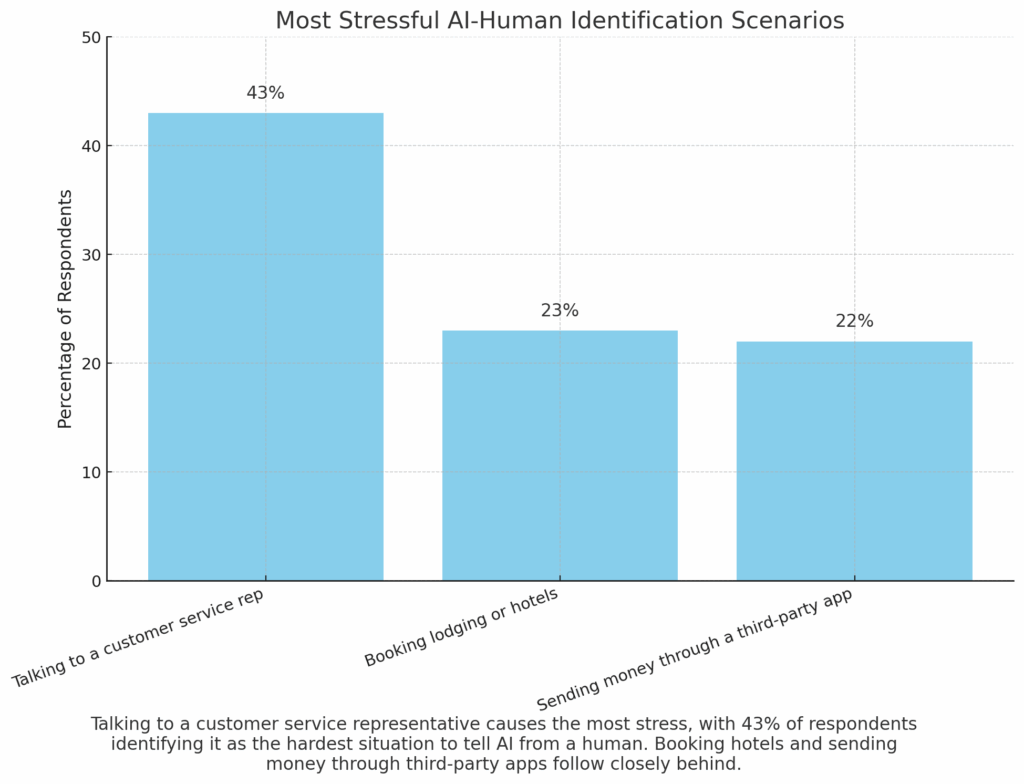
Impact of AI on Consumer Behavior
- 80% rely on reviews when deciding which businesses to support. (Talker Research)
- Bot-written reviews make 62% less likely to patronize a business. (Talker Research)
- AI customer service reps deter 50% of users. (Talker Research)
- AI-generated images deter 49% of users. (Talker Research)
- 46% have bought a product that wasn’t as advertised. (Talker Research)
- 24% of those buyers couldn’t return or get a refund. (Talker Research)
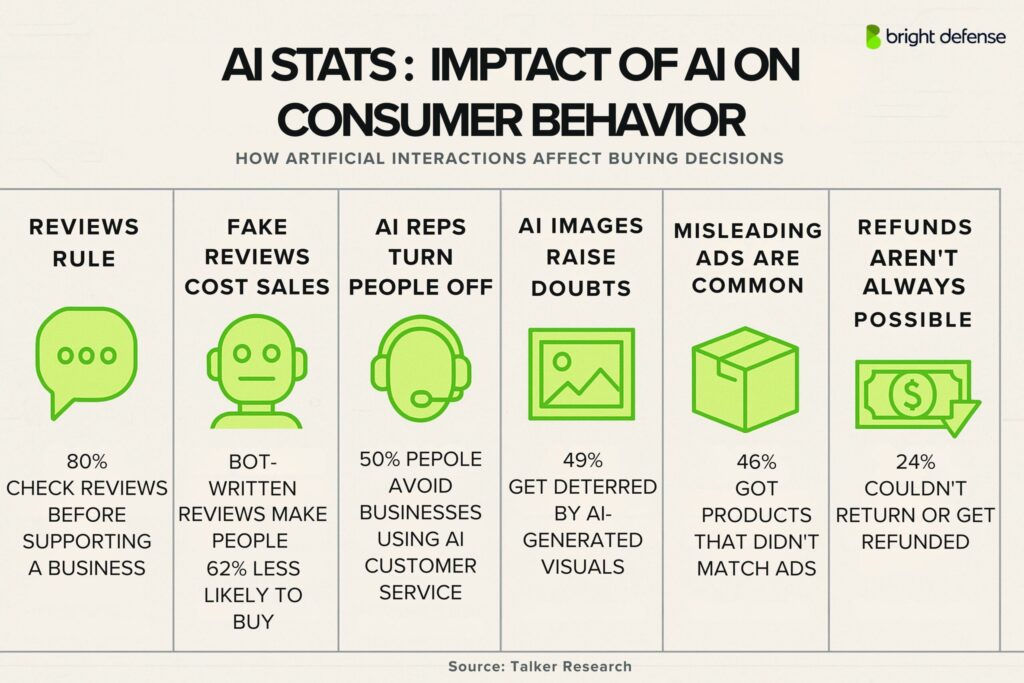
Cybersecurity Statistics By Country
- Czech Republic is the top-ranking country in terms of cybersecurity performance. The United States ranks 14th. The worst-performing nation is Kosovo. (NCSI)
- The United States had the highest average data breach costs in 2023 of any region. This was followed by the Middle East, Canada, Germany, and Japan. (The SSL Store)
- In 2023, the United States accounted for 47% of all ransomware attacks, the highest share worldwide. (Spacelift)
- 60% of large enterprises in the UK subcontract cybersecurity functions. (GOV.UK)
- The United Kingdom had the highest number of cybercrime victims per million internet users in 2022 at 4,783. This was up 40% from 2020. The United States was second at 1,494 victims per million, which represented a 13% decrease over 2020. (AAG IT)
- 31% of businesses in the UK are attacked at least once a week. (Ergonomics.org)
- 76% of respondents in the US, Canada, UK, Australia, and New Zealand experienced at least one cyber attack in 2022. (AAG IT)
- The Netherlands was most targeted for cyber attacks by both insiders (86%) and outsiders (84%). (Proofpoint)
- With an estimated 1.33 million professionals, the United States has the largest cybersecurity workforce in the world.
(StationX) - Customer data at 87% of small businesses could be compromised during an attack.
(Strong DM) - Of EMEA countries, organizations in Sweden were most likely to suffer a successful phishing attack. (Proofpoint)
- Only 35% of German organizations train their employees on insider threats. (Proofpoint)

Bright Defense is Your Cybersecurity Compliance Partner
Is cybersecurity a priority for you and your organization? Bright Defense can help. Our mission is to defend the world from cybersecurity threats through continuous compliance. We help you improve your security posture to help mitigate the risk of a data breach.
With our monthly service offering, our CISSP and CISA-certified security experts will develop and execute a cybersecurity plan to meet compliance standards, including SOC 2, CMMC, HIPAA, ISO 27001, and NIST. Our service includes:
- Gap analysis
- Risk assessment and risk management
- Generation and implementation of security policies
- Business continuity planning
- Certification assistance
We also include our managed compliance automation platform, security awareness training, phishing testing, and vCISO services.
Get started today with Bright Defense!
Get In Touch

